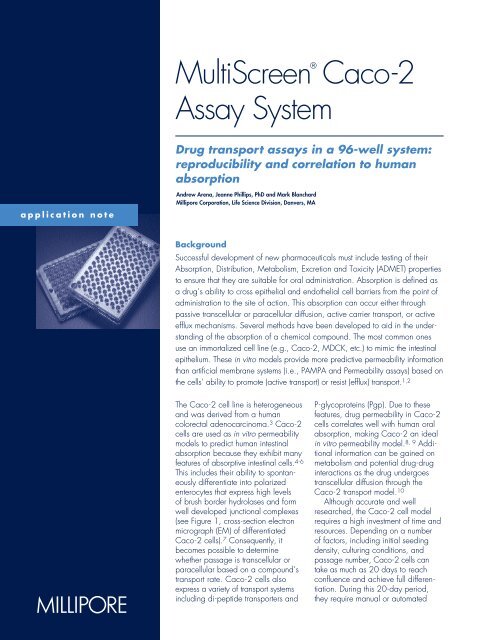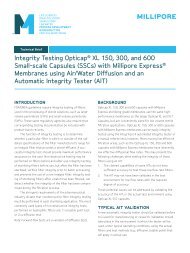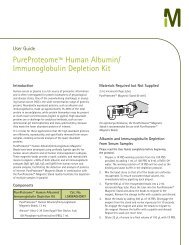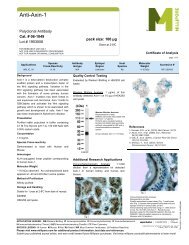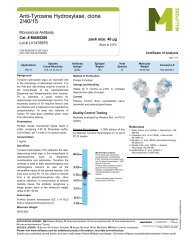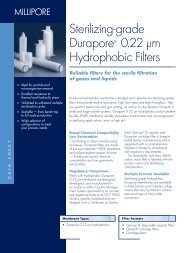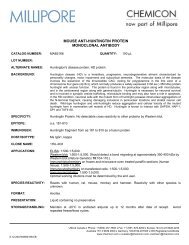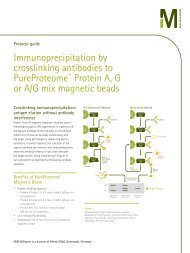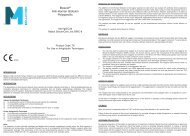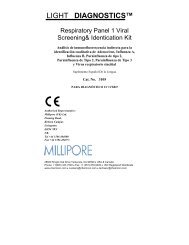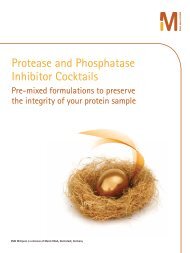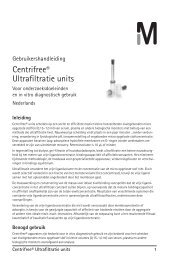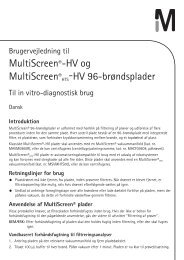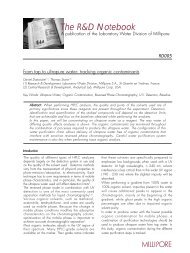MultiScreen Caco-2 assay system - Millipore
MultiScreen Caco-2 assay system - Millipore
MultiScreen Caco-2 assay system - Millipore
You also want an ePaper? Increase the reach of your titles
YUMPU automatically turns print PDFs into web optimized ePapers that Google loves.
application note<br />
Â<br />
<strong>MultiScreen</strong><br />
®<br />
<strong>Caco</strong>-2<br />
Assay System<br />
Drug transport <strong>assay</strong>s in a 96-well <strong>system</strong>:<br />
reproducibility and correlation to human<br />
absorption<br />
Andrew Arena, Jeanne Phillips, PhD and Mark Blanchard<br />
<strong>Millipore</strong> Corporation, Life Science Division, Danvers, MA<br />
Background<br />
Successful development of new pharmaceuticals must include testing of their<br />
Absorption, Distribution, Metabolism, Excretion and Toxicity (ADMET) properties<br />
to ensure that they are suitable for oral administration. Absorption is defined as<br />
a drug’s ability to cross epithelial and endothelial cell barriers from the point of<br />
administration to the site of action. This absorption can occur either through<br />
passive transcellular or paracellular diffusion, active carrier transport, or active<br />
efflux mechanisms. Several methods have been developed to aid in the understanding<br />
of the absorption of a chemical compound. The most common ones<br />
use an immortalized cell line (e.g., <strong>Caco</strong>-2, MDCK, etc.) to mimic the intestinal<br />
epithelium. These in vitro models provide more predictive permeability information<br />
than artificial membrane <strong>system</strong>s (i.e., PAMPA and Permeability <strong>assay</strong>s) based on<br />
the cells’ ability to promote (active transport) or resist (efflux) transport. 1,2<br />
The <strong>Caco</strong>-2 cell line is heterogeneous<br />
and was derived from a human<br />
colorectal adenocarcinoma. 3 <strong>Caco</strong>-2<br />
cells are used as in vitro permeability<br />
models to predict human intestinal<br />
absorption because they exhibit many<br />
features of absorptive intestinal cells. 4-6<br />
This includes their ability to spontaneously<br />
differentiate into polarized<br />
enterocytes that express high levels<br />
of brush border hydrolases and form<br />
well developed junctional complexes<br />
(see Figure 1, cross-section electron<br />
micrograph (EM) of differentiated<br />
<strong>Caco</strong>-2 cells). 7 Consequently, it<br />
becomes possible to determine<br />
whether passage is transcellular or<br />
paracellular based on a compound’s<br />
transport rate. <strong>Caco</strong>-2 cells also<br />
express a variety of transport <strong>system</strong>s<br />
including di-peptide transporters and<br />
P-glycoproteins (Pgp). Due to these<br />
features, drug permeability in <strong>Caco</strong>-2<br />
cells correlates well with human oral<br />
absorption, making <strong>Caco</strong>-2 an ideal<br />
in vitro permeability model. 8, 9 Additional<br />
information can be gained on<br />
metabolism and potential drug-drug<br />
interactions as the drug undergoes<br />
transcellular diffusion through the<br />
<strong>Caco</strong>-2 transport model. 10<br />
Although accurate and well<br />
researched, the <strong>Caco</strong>-2 cell model<br />
requires a high investment of time and<br />
resources. Depending on a number<br />
of factors, including initial seeding<br />
density, culturing conditions, and<br />
passage number, <strong>Caco</strong>-2 cells can<br />
take as much as 20 days to reach<br />
confluence and achieve full differentiation.<br />
During this 20-day period,<br />
they require manual or automated
2<br />
exchange of media as frequently as<br />
every other day. The transport <strong>assay</strong>s<br />
consume valuable drug compounds<br />
and normally require expensive, posttransport<br />
sample analyses (e.g.,<br />
LC/MS). Therefore, the use of the<br />
<strong>Caco</strong>-2 transport model in a high<br />
throughput laboratory setting is only<br />
possible if the platform is robust, automation<br />
compatible, reproducible,<br />
and provides high quality data that<br />
correlate well with established<br />
methodologies.<br />
Introduction<br />
The <strong>Millipore</strong> <strong>MultiScreen</strong> <strong>Caco</strong>-2<br />
<strong>assay</strong> <strong>system</strong> is a reliable 96-well<br />
platform for predicting human oral<br />
absorption of drug compounds (using<br />
<strong>Caco</strong>-2 cells or other cell lines whose<br />
drug transport properties have been<br />
well characterized). The <strong>MultiScreen</strong><br />
<strong>system</strong> format is automation compatible<br />
and is designed to offer more cost<br />
effective, higher throughput screening<br />
of drugs than a 24-well <strong>system</strong>. The<br />
<strong>MultiScreen</strong> <strong>Caco</strong>-2 <strong>assay</strong> <strong>system</strong><br />
Figure 1: Cross-sectional EM of<br />
Differentiated <strong>Caco</strong>-2 Cells<br />
exhibits good uniformity of cell growth<br />
and drug permeability across all<br />
96 wells and low variability between<br />
production lots. The plate design<br />
supports the use of lower volumes<br />
of expensive media and reduced<br />
amounts of test compounds. Using<br />
the <strong>MultiScreen</strong> <strong>Caco</strong>-2 <strong>assay</strong> <strong>system</strong>,<br />
standard drug compounds are<br />
successfully categorized as either "high"<br />
or "low" permeable, as defined by the<br />
Food and Drug Administration, and<br />
the permeability data correlate well<br />
with established human absorption<br />
values. 11<br />
The data presented in this Application<br />
Note demonstrates that drug<br />
permeability rates obtained using<br />
<strong>MultiScreen</strong> <strong>Caco</strong>-2 <strong>assay</strong> <strong>system</strong><br />
correlate well with published human<br />
intestinal absorption values. Addition<br />
ally, there is uniform performance<br />
within plates, when comparing one<br />
plate to another and when testing<br />
multiple plate lots. Correlation to<br />
human absorption was investigated<br />
directly through experiments done<br />
Figure 2: <strong>MultiScreen</strong> <strong>Caco</strong>-2 Assay System Components:<br />
System<br />
Components<br />
independently by ArQule, Inc. 12<br />
These results, encompassing testing<br />
of an extensive list of compounds,<br />
were originally presented in a poster<br />
at the 2002 AAPS Annual Meeting<br />
and Exposition in Toronto, Canada.<br />
Experiments were also performed<br />
comparing drug permeability rates<br />
measured with the <strong>MultiScreen</strong><br />
<strong>Caco</strong>-2 <strong>assay</strong> <strong>system</strong> to those<br />
measured using a 24-well <strong>system</strong>.<br />
The goal of this research was to<br />
determine whether data obtained with<br />
the <strong>Caco</strong>-2 <strong>MultiScreen</strong> <strong>assay</strong> <strong>system</strong><br />
(i.e., a 96-well platform) would be<br />
comparable to permeability results<br />
obtained using an established <strong>system</strong><br />
and thus, indirectly, provide additional<br />
correlation to percent human absorption.<br />
Finally, product variability was<br />
explored by testing the transport of<br />
propranolol in all 96 wells on multiple<br />
<strong>MultiScreen</strong> <strong>Caco</strong>-2 plates chosen<br />
from different production lots and<br />
seeded with cells on different days.<br />
Lid<br />
96-well<br />
Filter Plate<br />
Single-well<br />
Feeder Plate<br />
96-well Transport<br />
Analysis Plate<br />
<strong>MultiScreen</strong> <strong>Caco</strong>-2 <strong>assay</strong> <strong>system</strong> components (cat. MACA C02 B5, with single-well<br />
feeder plate) and 96-well transport analysis plate (cat. MACA C0R S5). Not shown,<br />
<strong>assay</strong> <strong>system</strong> components with 96-well feeder plate (cat. MACA C02 S5).
Materials and Equipment<br />
Tissue Culture<br />
Non-essential amino acids (cat.<br />
M7145), HEPES (cat. H0887),<br />
penicillin, streptomycin and<br />
L-glutamine (cat. G1146), EDTA<br />
(cat. E8008) trypsin/EDTA<br />
(cat. T3924), and the multiwell<br />
plate washer, 8-channel manifold<br />
(cat. M2656) were all purchased<br />
from Sigma Chemical Co. (St. Louis,<br />
MO). Fetal bovine serum (cat.<br />
16000044) and Hank’s balanced<br />
salt solution (HBSS) (cat. 14025) were<br />
purchased from Invitrogen (Carlsbad,<br />
CA). Multi-Screen <strong>Caco</strong>-2 <strong>assay</strong><br />
<strong>system</strong> (cat. MACAC02S5 or<br />
MACAC02B5) was purchased from<br />
<strong>Millipore</strong> Corporation (Bedford, MA).<br />
Corning HTS Transwell ® ‚ -24 plates<br />
and reservoirs (cat. 07200687 and<br />
08774162) and tissue culture flasks<br />
(cat. 1368065) were purchased from<br />
Fisher Scientific.<br />
Electrical Resistance Measurements<br />
Millicell ® -ERS probe for the 24-well<br />
plates (cat. MERSSTX01) and a<br />
Millicell-ERS ohm meter (cat.<br />
MERS00001) were obtained from<br />
<strong>Millipore</strong> Corporation. An electrode<br />
for measuring electrical resistance in<br />
the <strong>Millipore</strong> plate (cat. STX 100M)<br />
was purchased from World Precision<br />
Instruments (Sarasota, FL).<br />
Drug Transport Experiments<br />
Propranolol (cat. P0884), testosterone<br />
(cat. T1500), digoxin (cat. D6003),<br />
mannitol (cat. M9546), paclitaxel<br />
(Taxol ®) (cat. T1912), prednisone<br />
(cat. P6254), ibuprofen (cat. I1892),<br />
verapamil (cat. V4629), warfarin<br />
(cat. A2250) and methotrexate (cat.<br />
M8407) were purchased from Sigma<br />
Chemical Co. (St. Louis, MO). Radiolabeled<br />
mannitol (NET101), digoxin<br />
(NET222), propranolol (NET515),<br />
testosterone (NET553) and verapamil<br />
(NET810) were purchased from<br />
PerkinElmer (Boston, MA). Radiolabeled<br />
Taxol (MT-552), methotrexate<br />
(MT-701) and warfarin (MT-1620)<br />
were purchased from Moravek (Brea,<br />
CA). Radio-labeled ibuprofen<br />
(ART-392) and prednisone (ART-836)<br />
were purchased from ARC (St. Louis,<br />
MO). Wallac 1450 Microbeta ® Plus<br />
Scintillation Counter, Microbeta Trilux<br />
Multiwell Plate Scintillation Counter<br />
and Microbeta 96-well flexible plates<br />
(1450-401) were purchased from<br />
Wallac/PerkinElmer (Boston, MA).<br />
Methods<br />
Performing Drug Transport Assays<br />
For specific methods concerning<br />
Cultivation and Feeding of <strong>Caco</strong>-2<br />
Cells, Optimizing Cell Seeding<br />
Density for the <strong>MultiScreen</strong> <strong>Caco</strong>-2<br />
<strong>assay</strong> <strong>system</strong>, and Performing a Drug<br />
Transport Assay using the <strong>MultiScreen</strong><br />
<strong>Caco</strong>-2 <strong>assay</strong> <strong>system</strong>, see <strong>Millipore</strong><br />
Protocol Note PC1060EN00:<br />
Optimization of <strong>Caco</strong>-2 cell growth<br />
and differentiation for drug transport<br />
<strong>assay</strong> studies using a 96-well <strong>assay</strong><br />
<strong>system</strong>. 13<br />
In these experiments, <strong>Caco</strong>-2 cells<br />
were cultivated in tissue culture flasks<br />
to 80-90% confluence. Cells at passages<br />
33-35 were used to seed one<br />
<strong>MultiScreen</strong> <strong>Caco</strong>-2 plate (96-well<br />
filter plate from cat. MACAC02S5<br />
or MACAC02S2) and four 24-well<br />
plates for 21-day cell growth in four<br />
independent experiments (each<br />
experiment was performed on a<br />
different day). The optimal seeding<br />
density was determined to be 82,000<br />
cells per cm2 for the <strong>MultiScreen</strong> <strong>Caco</strong>-2<br />
plates, and 67,000 cells per cm2 for<br />
the 24-well plates. All plates were fed<br />
apically and basolaterally every other<br />
day.<br />
The transepithelial electrical<br />
resistance (TEER) was measured in<br />
each well after 21 days. (Wells that<br />
registered TEER values below 100<br />
ohms x cm2 did not meet previously<br />
established acceptance criteria for<br />
proper cell monolayer formation and<br />
the data from these wells were not<br />
incorporated into the graphs.) The<br />
plates were subsequently washed<br />
three times with sterile HBSS, pH 7.4.<br />
Ten tritium-labeled compounds were<br />
diluted 100-fold into solutions<br />
containing their respective unlabeled<br />
counterparts. This mixture was brought<br />
to a final concentration of 10 µM in<br />
HBSS, pH 7.4 and then, added<br />
apically to all 96 wells of each plate.<br />
Drug transport was determined after<br />
two hours (shaking at 37 °C, 5%<br />
CO2, 95% relative humidity) using<br />
a Trilux Multiwell Plate Scintillation<br />
Counter to measure counts per minute<br />
of radio-labeled drug. Drug permeability<br />
values were then calculated<br />
using the equation described in the<br />
next section.<br />
For detailed methods used by<br />
ArQule, Inc. see reference. 12 Briefly,<br />
cells between passage numbers<br />
18–25 were used in these<br />
experiments. <strong>MultiScreen</strong> <strong>Caco</strong>-2<br />
plates were seeded at a density of<br />
65,000 cells per cm 2 and the cells<br />
were grown for 21–28 days.<br />
Permeability of non-radio-labeled<br />
compounds (20 µM) was measured<br />
after two hours, with shaking at<br />
37 °C. Samples were analyzed<br />
using liquid chromatography/mass<br />
spectrometry. Permeability of radiolabeled<br />
compounds (trace amounts<br />
mixed with 1 µM of their respective<br />
unlabeled counterparts) was measured<br />
at different time points over 80 minutes.<br />
These samples were quantified using<br />
liquid scintillation counting.<br />
Evaluating the Reproducibility of<br />
Drug Transport Experiments<br />
For these experiments, cells at passage<br />
33 and 34 were used to seed plates<br />
from three different lots of MACAC02S5<br />
and one lot of MACAC02B5 for<br />
21-day cell growth in three independent<br />
experiments (each experiment<br />
was performed on a different day).<br />
The seeding density and performance<br />
of TEER evaluation and drug transport<br />
<strong>assay</strong>s are described above.<br />
3
Results<br />
Evaluation of Monolayer Integrity<br />
Prior to the start of all drug transport<br />
experiments, the TEER was measured<br />
in every well to confirm monolayer<br />
integrity. The TEER measurements for<br />
all experiments discussed in this<br />
section were typically in the range<br />
of 200 to 350 ohms x cm2 (data<br />
not shown). This range is indicative<br />
of successful formation of integral<br />
monolayers after 21 days of culture.<br />
The corresponding drug transport data<br />
confirm differentiated monolayers<br />
with tight junctions.<br />
Correlation of Drug Transport Rates<br />
to Human Absorption<br />
Historically, it has been shown that a<br />
sigmoidal relationship exists between<br />
drug absorption rates as measured<br />
with the in vitro <strong>Caco</strong>-2 model and<br />
human absorption. 8 Drug compounds<br />
representing active, passive, and<br />
4<br />
Equation 1<br />
The apparent permeability (Papp), in units of centimeters per second,<br />
can be calculated for <strong>Caco</strong>-2 drug transport <strong>assay</strong>s using the following<br />
equation8 :<br />
Papp =<br />
V A<br />
[drug] acceptor<br />
( ) • ( )<br />
Area • time<br />
[drug] initial, donor<br />
Where VA is the volume (in mL) in the acceptor well, Area is the surface<br />
area of the membrane (0.11 cm 2 for <strong>MultiScreen</strong> <strong>Caco</strong>-2 plate and 0.3 cm 2<br />
for the 24-well plate), and time is the total transport time in seconds. For<br />
radio-labeled drug transport experiments, the CPM units obtained from<br />
the Trilux Multiwell Plate Scintillation Counter were used directly for the<br />
drug acceptor and initial concentrations such that the formula becomes:<br />
Equation 2<br />
Papp =<br />
V A<br />
CPMacceptor<br />
( ) • ( )<br />
Area • time<br />
CPMinitial, donor<br />
efflux transporters were tested at<br />
ArQule, Inc. using the <strong>MultiScreen</strong><br />
<strong>Caco</strong>-2 <strong>assay</strong> <strong>system</strong>. 12 Each<br />
compound’s permeability rate was<br />
plotted against their percent human<br />
absorption values (Figure 3). The<br />
passive diffusion compounds included<br />
in this evaluation were carbamazepine,<br />
mannitol, penicillin, caffeine, buspirone,<br />
metoclopramide, haloperidol, promethazine,<br />
and imipramine. The active<br />
influx compounds were methotrexate,<br />
piroxicam, salicylic acid, and Gly-Sar.<br />
The efflux compounds included were<br />
loperamide, clomipramine, metolazone,<br />
alprenolol, timolol, metoprolol,<br />
digoxin, chlorpromazine, quinine,<br />
paclitaxel, thiacetazone, acebutolol,<br />
sulfasalazine, doxorubicin, and<br />
thioridazine. Using Statistica (Stat<br />
Soft Corporation, Tulsa, OK), a<br />
nonlinear regression curve,<br />
(% human absorption =100 x exp (a + b x Papp)/(1 + exp [a + b x Papp])<br />
Equation 2, was generated and<br />
provided a good fit to all of the data<br />
points. Statistical analysis of the curve<br />
suggested that there were no significant<br />
differences in fit based on<br />
whether the drug was absorbed<br />
actively, passively or effluxed (ANOVA<br />
F-test on single curve ranked residuals;<br />
p=0.33). Based on the curve fit,<br />
transport rates were typically > 1.0 x<br />
10 -5 cm/s and < 1.0 x 10 -6 for high<br />
and low permeable compounds,<br />
respectively. Intermediate compounds<br />
were estimated to have an upper limit<br />
of permeability of ~7.0 x 10 –6. This<br />
study demonstrated that the <strong>MultiScreen</strong><br />
<strong>Caco</strong>-2 <strong>assay</strong> <strong>system</strong> could correctly<br />
identify and classify the permeability<br />
properties of all 25 compounds tested.
Figure 3: Correlation of Drug Transport Rates to Human Absorption*<br />
% Human Absorption<br />
*One outlier, terfenadine, which had a Papp of 1x10 -7 cm/s and % human abs =100%, was not included.<br />
24-well (cm/s)<br />
100<br />
80<br />
60<br />
40<br />
20<br />
0<br />
1.0 x10 -7 1.0 x10 -6 1.0 x10 -5 1.0 x10 -4<br />
Correlation of Drug Transport<br />
Rates to 24-well Plate Results<br />
A significant amount of literature<br />
supports the use of a 24-well <strong>system</strong><br />
for in vitro drug permeability models.<br />
When developing or validating a<br />
96-well platform, it is important to<br />
correlate data to results obtained<br />
using previously established methods.<br />
Experiments using the same cells and<br />
methods were performed to compare<br />
the drug transport rates obtained from<br />
the <strong>MultiScreen</strong> <strong>Caco</strong>-2 <strong>assay</strong> <strong>system</strong><br />
Figure 4: Comparison of Permeability Rates: <strong>MultiScreen</strong> <strong>Caco</strong>-2 and 24-well<br />
Assay Systems<br />
4.0x10 -5<br />
3.5x10 -5<br />
3.0x10 -5<br />
2.5x10 -5<br />
2.0x10 -5<br />
1.5x10 -5<br />
1.0x10 -5<br />
0.5x10 -5<br />
0<br />
0<br />
R 2 =0.99<br />
Papp (cm/sec)<br />
1.0x10 -5 2.0x10 -5 3.0x10 -5 4.0x10 -5<br />
and an established 24-well <strong>system</strong>.<br />
<strong>Caco</strong>-2 permeability rates using<br />
10 tritium labeled drugs (mannitol,<br />
digoxin, propranolol, testosterone,<br />
Taxol, prednisone, verapamil,<br />
warfarin, ibuprofen, and methotrexate)<br />
were measured using the <strong>MultiScreen</strong><br />
<strong>Caco</strong>-2 or 24-well <strong>assay</strong> <strong>system</strong>.<br />
Data from four separate experiments<br />
are compared in Figure 4. The R 2<br />
value of 0.99 suggests that the data<br />
between the two different formats (i.e.,<br />
24-well and 96-well) correlate well.<br />
<strong>MultiScreen</strong> <strong>Caco</strong>-2 (cm/s)<br />
5.0x10 -5 6.0x10 -5<br />
Note: The average transport rates used to create Figures 4 and 5 do not include any replicates that<br />
were obvious outliers. This was seen in more than one experiment and occurred in both products.<br />
Further evidence of good correlation<br />
is demonstrated when the transport<br />
rates (excluding digoxin and Taxol)<br />
are plotted against human absorption<br />
values (Figure 5). The same curve<br />
generated in Figure 3 adequately<br />
fits both sets of data. Thus, when<br />
adopting the <strong>MultiScreen</strong> <strong>Caco</strong>-2<br />
<strong>assay</strong> <strong>system</strong> for in vitro permeability<br />
studies, it is expected that the data<br />
will correlate to a 24-well <strong>system</strong>.<br />
5
Figure 5: Papp vs. Human Absorption —Comparison of <strong>MultiScreen</strong><br />
<strong>Caco</strong>-2 and 24-well Assay Systems<br />
% Human Absorption<br />
Note: The average transport rates used to create Figures 4 and 5 do not include any replicates that<br />
were obvious outliers. This was seen in more than one experiment and occurred in both products.<br />
Reproducibility of Drug Transport Rates<br />
The reliability of cell-based in vitro<br />
methods is contingent upon minimizing<br />
the variability contributed by the cell<br />
growth platform. The use of multi-well<br />
plates for growing cells in long-term<br />
cultures may present a challenge from<br />
both an environmental and industrial<br />
perspective. During culture, even in a<br />
humidity-controlled incubator, elevated<br />
temperatures can cause evaporation<br />
to occur more rapidly in the outer<br />
wells of the plate as compared to the<br />
inner wells. Minor differences in the<br />
seeding of plates from day to day<br />
may also contribute to variability.<br />
Based on these factors, reproducibility<br />
of drug transport rates was examined<br />
in the <strong>MultiScreen</strong> <strong>Caco</strong>-2 <strong>assay</strong><br />
6<br />
100<br />
80<br />
60<br />
40<br />
20<br />
0<br />
1.0x10-7 1.0x10-6 1.0x10-5 1.0x10-4 Equation 3<br />
Equation 4<br />
24 well<br />
<strong>MultiScreen</strong><br />
Papp (cm/sec)<br />
<strong>system</strong> using a 21-day culture of<br />
<strong>Caco</strong>-2 cells and a single drug,<br />
propranolol, in all 96 wells of every<br />
plate tested. Transport rates were<br />
determined in the apical to basolateral<br />
direction. The components of variation<br />
were calculated from the data set<br />
consisting of three experimental runs<br />
performed on different days. Each run<br />
consisted of four different production<br />
lots of Multi-Screen <strong>Caco</strong>-2 plates,<br />
three lots with 96-well feeder trays<br />
(feeder tray from cat. MACA CO2 S5),<br />
and one lot with a single-well feeder<br />
tray (feeder tray from cat. MACA<br />
CO2 B5).<br />
The intra-plate comparison of<br />
propranolol transport in the outer<br />
36 wells versus the inner 60 wells<br />
(intra-plate SD) 2 + (inter-plate SD2 total SD = √<br />
)<br />
95% confidence = (overall plate average) ± (2 • total SD)<br />
was plotted for all 12 plates in this<br />
study (figure not shown). The resultant<br />
R 2 =0.9 confirms that the average<br />
value and variability of the external<br />
wells (n=36) was statistically similar to<br />
the average value and variability of<br />
the internal wells (n=60).<br />
Analysis of variance on the plate<br />
averages, inter-plate and intra-plate<br />
standard deviations (SD) was determined<br />
for all 12 plates. The overall<br />
plate average permeability rate for<br />
these experiments is 1.5 x 10 -5 cm/sec.<br />
The intra-plate and inter-plate standard<br />
deviations are estimated at 0.2 x10 -5<br />
cm/sec and do not vary significantly<br />
among the production lots or test days<br />
(p > 0.07 and p > 0.17, respectively).<br />
Using these values, the total standard<br />
deviation (total SD) of a single<br />
measurement is calculated to be<br />
0.3 x10 -5 cm/sec using Equation 3.<br />
Therefore, 95% of all results from<br />
a propranolol transport experiment,<br />
using the <strong>MultiScreen</strong> <strong>Caco</strong>-2 <strong>assay</strong><br />
<strong>system</strong>, are predicted to fall within<br />
the range determined using Equation 4.<br />
This predicts that 95% of all propranolol<br />
transport rates (apical to basolateral)<br />
in this study should fall within the<br />
range of 0.9 to 2.1 x 10 -5 cm/sec.<br />
These experiments also demonstrate<br />
that the confidence range should be<br />
achieved independent of well position,<br />
plate production lot, type of feeding<br />
tray used, or day of experiment<br />
(Figure 6). A line representing the<br />
upper limit of low permeability<br />
compounds (extrapolated from<br />
Figure 3) is drawn to demonstrate that<br />
the 95% confidence range clearly<br />
distinguishes propranolol as a high<br />
versus a low permeable compound.
Figure 6: Inter-plate Variation of Propranolol Transport*<br />
Papp (cm/sec)<br />
1.0x10 -4<br />
1.0x10 -5<br />
1.0x10 -6<br />
1.0x10 -7<br />
Discussion<br />
<strong>Caco</strong>-2 cells are heterogeneous and<br />
their properties in final culture may<br />
differ based on the selection pressures<br />
of a particular laboratory. Direct<br />
comparison of compound permeability<br />
rates between laboratories is<br />
not possible unless the same <strong>Caco</strong>-2<br />
cells and conditions are used. 14<br />
Therefore, transport rates and permeability<br />
classification ranges of specific<br />
drugs are expected to vary from data<br />
presented in this Application Note.<br />
Most important is the ability to<br />
successfully classify compounds as<br />
low, medium or high permeable<br />
drugs and produce transport results<br />
that correlate to established human<br />
absorption values. The Multi-Screen<br />
<strong>Caco</strong>-2 <strong>assay</strong> <strong>system</strong> satisfies these<br />
requirements as evidenced by the<br />
data presented in Figure 3. Extrapolations<br />
from that curve produced<br />
ranges that correctly classified all<br />
compounds based on permeability.<br />
The comparison studies with the<br />
24-well <strong>system</strong> yielded a high degree<br />
of correlation. This similarity to established<br />
<strong>system</strong>s demonstrates that the<br />
<strong>MultiScreen</strong> <strong>Caco</strong>-2 <strong>system</strong> can be<br />
Lot #1 Lot #2 Lot #3 Lot #4<br />
Upper limit of low permeation (~1.0 x 10 -6 )<br />
2.1 x 10 -5<br />
0.9 x 10 -5<br />
1 2 3 1 2 3 1 2 3 1 2 3<br />
*Note: Each data point represents a single plate and the average and standard deviation of 96 wells<br />
Day<br />
used in place of 24-well <strong>system</strong>s as a<br />
platform for increasing the throughput<br />
and/or automating in vitro permeability<br />
screening <strong>assay</strong>s.<br />
Although inter-laboratory variability<br />
is likely to remain an issue when using<br />
<strong>Caco</strong>-2 cell methods, the <strong>Caco</strong>-2<br />
<strong>MultiScreen</strong> <strong>assay</strong> <strong>system</strong> will provide<br />
low variability within a laboratory along<br />
with correct compound classification<br />
(Figure 6).<br />
Conclusion<br />
The results presented in this Application<br />
Note demonstrate that the <strong>MultiScreen</strong><br />
<strong>Caco</strong>-2 <strong>assay</strong> <strong>system</strong> provides a<br />
robust and reproducible method for<br />
predicting human absorption of druglike<br />
compounds. The plates—which<br />
are compatible with a wide range of<br />
laboratory robotics—are designed to<br />
grow stabile, differentiated monolayers<br />
and provide reliable and accurate<br />
<strong>Caco</strong>-2 permeability data.<br />
References<br />
1. Kansy, M., et al., Physicochemical<br />
high throughput screening: parallel<br />
artificial membrane permeation<br />
<strong>assay</strong> in the description of passive<br />
absorption processes, J. Med.<br />
Chem., 1998. 41:1007–1010.<br />
2. Wohnsland, F. and Faller, B.,<br />
High-throughput permeability pH<br />
profile and high-throughput<br />
alkane/water log P with artificial<br />
membranes, J. Med. Chem.,<br />
2001. 44:923–930.<br />
3. Fogh J , et al., One hundred and<br />
twenty-seven cultured human<br />
tumor cell lines producing tumors<br />
in nude mice, J. Natl. Cancer<br />
Inst., 1977. 59:221–226.<br />
4. Pinto, M., et al., Enterocyte-like<br />
differentiation and polarization of<br />
the human colon carcinoma cell<br />
line <strong>Caco</strong>-2 in culture, Biol. Cell,<br />
1983. 47:323–330.<br />
5. Hidalgo, I.J., et al., Characterization<br />
of the human colon carcinoma cell<br />
line (<strong>Caco</strong>-2) as a model <strong>system</strong><br />
for intestinal epithelial permeability,<br />
Gastroenterology, 1989.<br />
96:736–749.<br />
7
6. Wilson, G., et al.,Transport and<br />
permeability properties of human<br />
<strong>Caco</strong>-2 cells: An in vitro model of<br />
the intestinal epithelial cell barrier.<br />
J. Controlled Release, 1990.<br />
11:25–40.<br />
7. Phillips, J., et al., Performance<br />
Characterization of a 96-Well<br />
Filter Plate in Drug Transport<br />
Assays Using <strong>Caco</strong>-2 Cells and<br />
Automation. Poster, Laboratory<br />
Automation. Palm Springs, CA,<br />
2002.<br />
8. Artursson, P. and Karlsson, J.,<br />
Correlation between oral drug<br />
absorption in humans and<br />
apparent drug permeability<br />
coefficients in human intestinal<br />
epithelial (<strong>Caco</strong>-2) cells.<br />
Biochem. Biophys. Res. Comm.,<br />
1991, 175:880–885.<br />
9. Artursson, P., Epithelial transport<br />
of drugs in cell culture. I: A model<br />
for studying the passive diffusion<br />
of drugs over intestinal absorptive<br />
(<strong>Caco</strong>-2) cells. J. Pharm. Sci.,<br />
1990. 79:476–482.<br />
10. Rosenberg, D.W. and Leff, T.,<br />
Regulation of cytochrome P450<br />
in cultured human colonic cells.<br />
Arch. Biochem. Biophys, 1993.<br />
300:186-192.<br />
Related Protocol Notes<br />
PC1060EN00: Optimization of <strong>Caco</strong>-2 cell growth and differentiation for<br />
drug transport <strong>assay</strong> studies using a 96-well <strong>assay</strong> <strong>system</strong><br />
PC1061EN00: Optimization of MDCK cell growth and differention for<br />
drug transport <strong>assay</strong> studies using a 96-well <strong>assay</strong> <strong>system</strong><br />
Â<br />
11. U.S. Department of Health and<br />
Human Services, Food and Drug<br />
Administration, Center for Drug<br />
Evaluation and Research (CDER),<br />
Waiver of in vivo bioavailability<br />
and bioequivalence studies for<br />
immediate-release solid oral<br />
dosage forms based on a<br />
biopharmaceutics classification<br />
<strong>system</strong>, Guidance for Industry,<br />
August 2000.<br />
http://www.fda.gov/<br />
cder/guidance/3618fnl.htm<br />
12. Yu, H., et al., Validation of 96-<br />
Well Insert Plates in the <strong>Caco</strong>-2<br />
Permeability Screening Assay.<br />
Poster, AAPS Annual Meeting and<br />
Exposition, Toronto, Canada,<br />
2002.<br />
13. Phillips, J. and Arena, A.,<br />
Optimization of <strong>Caco</strong>-2 Cell<br />
Growth and Differentiation for<br />
Drug Transport Studies. <strong>Millipore</strong><br />
Corporation Protocol Note<br />
PC1060EN00, 2003.<br />
14. Artursson, P. et al., <strong>Caco</strong>-2<br />
monolayers in experimental and<br />
theoretical predictions of drug<br />
transport. Adv. Drug Deliv.<br />
Rev., 2001. 46:27-43.<br />
To Place an Order or<br />
Receive Technical Assistance<br />
For additional information call your<br />
nearest <strong>Millipore</strong> office.<br />
In the U.S. and Canada, call toll-free<br />
1-800-MILLIPORE<br />
(1-800-645-5476)<br />
In the U.S., Canada and Puerto Rico,<br />
fax orders to 1-800-MILLIFX<br />
(1-800-645-5439)<br />
Internet: www.millipore.com<br />
Tech Service:<br />
www.millipore.com/techservice<br />
Now you can buy<br />
<strong>Millipore</strong> products<br />
online @<br />
www.millipore.com/purecommerce<br />
<strong>Millipore</strong>, <strong>MultiScreen</strong>, Millicell and Milli-Q are<br />
registered trademarks of <strong>Millipore</strong> Corporation.<br />
Lab-Line is a registered trademark of Lab-Line<br />
Instruments, Inc.<br />
Wallac Victor 2 is a trademark of PerkinElmer or an<br />
affiliated company.<br />
Microbeta is a registered trademark of Wallac Oy.<br />
Taxol is registered trademark of the Bristol-Meyers<br />
Squibb Company.<br />
Transwell is a registered trademark of Corning, Inc.<br />
Fisher Scientific is a registered trademark of Fisher<br />
Scientific LLC.<br />
Statistica is a trademark of StatSoft, Inc.<br />
Lit. No. AN1727EN00 Rev.– 9/03 03-242<br />
Printed in the U.S.A.<br />
© 2003 <strong>Millipore</strong> Corporation, Billerica, MA U.S.A.<br />
All rights reserved.


